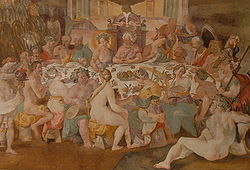
Villa di Corliano
Encyclopedia


Villa
A villa was originally an ancient Roman upper-class country house. Since its origins in the Roman villa, the idea and function of a villa have evolved considerably. After the fall of the Roman Republic, villas became small farming compounds, which were increasingly fortified in Late Antiquity,...
situated near coast of Tuscany
Tuscany
Tuscany is a region in Italy. It has an area of about 23,000 square kilometres and a population of about 3.75 million inhabitants. The regional capital is Florence ....
, central Italy
Italy
Italy , officially the Italian Republic languages]] under the European Charter for Regional or Minority Languages. In each of these, Italy's official name is as follows:;;;;;;;;), is a unitary parliamentary republic in South-Central Europe. To the north it borders France, Switzerland, Austria and...
, in the valley between Lucca
Lucca
Lucca is a city and comune in Tuscany, central Italy, situated on the river Serchio in a fertile plainnear the Tyrrhenian Sea. It is the capital city of the Province of Lucca...
and Pisa
Pisa
Pisa is a city in Tuscany, Central Italy, on the right bank of the mouth of the River Arno on the Tyrrhenian Sea. It is the capital city of the Province of Pisa...
, 2 kilometres from the Spa town
Spa town
A spa town is a town situated around a mineral spa . Patrons resorted to spas to "take the waters" for their purported health benefits. The word comes from the Belgian town Spa. In continental Europe a spa was known as a ville d'eau...
of San Giuliano Terme
San Giuliano Terme
San Giuliano Terme is a comune in the Province of Pisa in the Italian region Tuscany, located about 60 km west of Florence and about 7 km northeast of Pisa.- Main sights :...
. It is one of the numerous villas that built by the Pisan merchants as summer houses, along the fertile west slopes of Mount Pisano.
On both sides of the villa, decorated with typical Florentine Mannerist 16th century graffiti (harpy eagles, fruit crowns and flowers, birds and other symbols, representing the virtues of Fortress, Abundance and Fortune) are the farm and the oil mill, dating to the end of 17th Century. In 1755, on the occasion of the wedding of Maria Teresa Scolastica Ottavia della Seta Gaetani Bocca with Count Cosimo Baldassarre Agostini Fantini Venerosi, the villa was restored by the Veronese architect Ignazio Pellegrini.
In the vestibule there are some 18th century marble busts representing Roman Emperors, while the vault is painted with a mythological scene representing Paris awarding Venus the fruit, under the watchful June and Minerva’s stare. In the lateral ovals there are the Cathedral Square of Pisa, the original view of the villa, Piana della Croce Mount (Apuan Alps), the Gulf of Lerici, two unknown castles and the commissioners’ portraits. In the central hall is a vault, with a fresco representing The Gods’ Banquet) and months and zodiacal signs allegorical representations, by the Florentine painter Andrea Boscoli
Andrea Boscoli
Andrea Boscoli was an Italian painter of the Renaissance.He was born in Florence, where he trained under Santi di Tito. He painted a St. John preaching for the church of the Teresiani at Rimino. He also painted portraits. He died about 1606.-References:...
. On the walls are 18th century fresco paintings with the Four Seasons, attributed to Natili and Matraini, as are the ones in the little church.
The 4 hectares
Hectare
The hectare is a metric unit of area defined as 10,000 square metres , and primarily used in the measurement of land. In 1795, when the metric system was introduced, the are was defined as being 100 square metres and the hectare was thus 100 ares or 1/100 km2...
private park
Park
A park is a protected area, in its natural or semi-natural state, or planted, and set aside for human recreation and enjoyment, or for the protection of wildlife or natural habitats. It may consist of rocks, soil, water, flora and fauna and grass areas. Many parks are legally protected by...
has been changed several times in the centuries, according to the different age's trends. The current garden layout is from the 19th century.
Corliano belongs to a wider estate complex constituted by the ancient villa, the aristocratic chapel, the farm, the oil mill, stables, the kaffeehaus, the park, rural annexes, the boundary wall and monumental entrance, which was under control due to its historical-artistic interest pursuant to Italian Laws.
External links
- Associazione Dimore Storiche Italiane
- Villa di Corliano photos
- Villa di Corliano stage
- Villa Corliano map
- http://www.youtube.com/watch_popup?v=OuEDqUgFy1U#t=21Backstage "Le disgrazie d'Amore" di Antonio CestiAntonio CestiAntonio Cesti , known today primarily as an Italian composer of the Baroque era, he was also a singer , and organist. He was "the most celebrated Italian musician of his generation".- Biography :...
into the Corliano hall] - video of the Corliano hall


